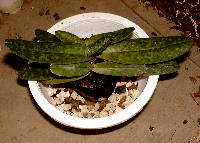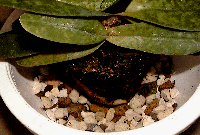The procedure of growing the bigger plants
A: Transplanting of Brachypetalum
For growing the bigger plants of Brachypetalum, the transplanting is the start for it. As I have mentioned before, the point is not to transplant after the first one.When we grow another kinds of orchid, we will change the pot to be bigger step by step. But for growing Brachypetalum, I use the bigger pot from the first considering the plant's size about a few fears latter. In some case, we might image it over 10 years latter.
1)Using plastic pots(my favorite plastic pots)
The plastic pots in the photo bellow is recommended for suitable growing the bigger Brachypetalum from my own experience. These pots are not special one and are sold anywhere for the usual flower and fern. Usually, we see two types. The bigger , the right one , is 18.5cm with a diameter and the smaller one is 13.5cm with a diameter. You may use whichever. It is dependent on the kind of species, the basic size of plants and the growing speed of the plant. I use the bigger one for Paph. bellatulum, concolor and conco-bellatulum and the smaller one for Paph. niveum, godefroyae, ang thong and leucochilum. The better points of this pot is dependent on the shape. I guess, the root of plant grow well in this shape and the water will be easy to path through and will not stagnant. It is very useful for management of water in the pot.
These pots are sold in home center for usual flower nad fern.Right one is the bigger size of 18.5 cm and left one is the smaller size of 13.5 cm with a diameter.
2)Transplanting(including compost)
In this photo, I want to introduce the practical procedure of transplanting using Paph. Psyche that is not a species. The plant in photo bellow, Paph. Psyche is very healthy and vivid plant with 2 shoots and potted in crypt moss of plastic pot with 5 cm diameter. Now, I 'll transplant this plant to the bigger pot with 13.5cm with diameter that is introduced above.
(1)First of all, the special stone , Certone ( L size ) will be lied on the base of pot. Ceraton is the special stone of ceramic material and it is helpful to keep water fresh and absolve acidic chemicals released from plants like Zeorite(Sorry, in Japanese only now). This is very useful for me. I love this material so much.
(2)The following, the mix compost that is introduced in the other site will be lied on the Ceramic layer above. Please consider the size for this purpose. Because, we have to choose the bigger size that we expect usually for the future, a few years latter at least.
And, I have introduced the basic rate and the kinds of materials for mix compost in the other site. Please check if you are interested in . But I advice you to modify the rate slightly dependent on the kinds of species. And Don't forget that the growing condition is dependent on your own habit for watering, the amount and interval etc. You have to consider the rate and the size of the materials by your self. Don't try change your own habit for the plants. It must be continued to be good. So I want to say that you change the materials in pots adjusted for your habit.
In Brachypetalum, we have 2 groups in the difference of their distribution. One groups contains Paph. niveum, ang thong godefroyae and leucochilum that distribute in the middle area of Malay Peninsula and grow on lime stone. They like dry condition fundamentally and need the higher temperature to cultivate. On the other hand, Paph. bellatulum and concolor grow inland and like thick layer of leaf mold on lime stone. Further more, they endure the lower temperature and like water much more than the former species. So, when you grow the former species, you make less rate of wood material and more rate of stone material for the mix. For the latter species, the rate of woody material will be greater than the rate of stone material. At the same time, we have to consider the size of material. When we use the smaller size, the material will keep water for long time.
NOTE:I don't use lime stone that Brachypetalum grow on in nature and many fans tried and discussed for long time about it.
Exactly, many kinds of Paphiopedilums grow on lime stone and it might be very important to grow Paphs well. For long time, many many Paph. fans tried and said various results. From my own experience, I could not identify the remarkable results in using lime stone in the mixture. As you know that Paphiopedilum grow so slowly, it might be very difficult to identify the result well. But I guess, we have to consider other problems to grow well before considering minor problems. I guess, pH or Ca ion from lime stone will be minor factor for growing Paphiopedilum in our green house. For us, we have the major problems like the kinds of compost, watering , sun shine and shade, wind, temperature. These problems will be concerned with alive or death of Paphiopedilums directly. I never say it is not important in nature in truth. It must be important in nature. But don't forget we grow then in the typical artificial condition , especially in pot that are limited area for roots of plants. So, the artificial problems is much more important to grow well before considering about the minor problems. If you grow Paphs in very good condition like their own nature, the minor problems that i mentioned above must be very important. But almost of all Paph. fans can not grow well, I guess. I have to beg your pardon, if you grow well. ' Very sorry ' So, we have to consider the fundamental procedure for growing Paphiopedilums. Change the subjects, although I have never seen the data about the soil of their growing、I guess the pH of soil will be acidic even if on lime stone. It is very difficult to dissolve calcium, lime stone in water. So I don't know how much it dissolve and affect Paphiopedilums. Considering about that, it is possible. Because lime stone will be dissolved with acidic water that is rain dissolved CO2 . But the amount should be very slightly. I tried Oyster shell tablet bought in Pharmacy in USA in order to give Ca ion to them. I thought it is easier to give by the tablet. But I could not identify the remarkable results. It might be that my technique of growing Paph is not enough for check the minor problems. In future, I hope, I and you will be able to grow Brachypetalums very well in the ideal condition. But don't for get we have a lot of problems that we have to overcome now.
(3) Put the plants that is taken off from the previous pot on the layer of the mix compost of new pot. In this time, be careful not to destroy the used compost, decayed crypt moss in this case. And be careful not to heart the new roots.
The used crypt moss was decayed so much but the new root will extend well, you can see. If the transplanting of this plant from the previous condition, the new root will be rotted in near future. And if the root would be rotted, the plants does not grow well and it takes about 2 years to be the good condition of our expect.
(4) Put the mix compost around the plants not to heart their root. Finishing the compost, you put the plant in pot sink in water bath from the bottom of pot and wet the compost.
(5)The plants will be kept in the darker,warmer area and more winds for a few month. Please keep your eyes to the plants. If you find some difference urgent, you have to correspond for it. Especially, the plants is damaged by spider mites and/or mealybugs, might be infected by microorganisms and cause the rotted disease. Before transplanting, you check it and work out countermeasures. But if you don't know the damage and have transplanted already, you had better spray medicine of the mixture of an insecticide and a disinfectant.
Continue to No.3








